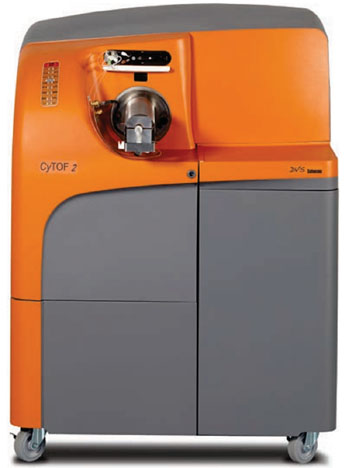Surgical Recovery Correlates with Single-Cell Immune Signatures
By LabMedica International staff writers
Posted on 15 Oct 2014
The activity level of a small set of immune cells during the first 24 hours after surgery provides strong clues to how quickly patients will recover from surgery-induced fatigue and pain. Posted on 15 Oct 2014
A highly sensitive technology, called single-cell mass cytometry, enables simultaneous monitoring of large numbers of biochemical features both on the surfaces of immune cells and within the cells, providing information of what kind of cells are present and whether they are active.

Image: The CyTOF Mass Cytometer for High-Dimensional Single Cell Analysis (Photo courtesy of the University of Virginia).
Scientists at Stanford University Medical Center (CA, USA) recruited 32 otherwise healthy patients, mostly between ages 50 and 80, who were undergoing first-time hip-replacement procedures. Blood samples from these patients were drawn 1 hour before surgery, then at 1, 24 and 72 hours postsurgery and again four to six weeks after surgery. Cytometric analysis of 35 features in and on each sample's roughly half-million constituent cells yielded profiles of the cells' identities along with key activities underway inside them. Stained cells were analyzed on a CyTOF mass cytometer (DVS Sciences; Sunnyvale, CA, USA) at an event rate of 400 to 500 cells per second.
The simultaneous analysis of 14,000 phosphorylation events in precisely phenotyped immune cell subsets revealed uniform signaling responses among patients, demarcating a surgical immune signature. When regressed against clinical parameters of surgical recovery, including functional impairment and pain, strong correlations were found with signal transducer and activator of transcription (STAT3), adenosine 3′,5′-monophosphate response element–binding protein (CREB) , and nuclear factor κB (NF-κB) signaling responses in subsets of cluster of differentiation 14+ (CD14+) monocytes. The cells in question account for only about 1% to 2% of all the white blood cells found in a typical sample of a healthy person's blood, so the changes within them could easily have been missed had a less-thorough detection technology been employed.
Brice Gaudilliere, MD, PhD, a lead author of the study, said, “If we could predict recovery time before surgery even took place we might be able to see who'd benefit from boosting their immune strength beforehand, or from presurgery interventions such as physical therapy. It might even help us decide when or if a patient should have surgery.” The study was published on September 24, 2014, in the journal Science Translational Medicine.
Related Links:
Stanford University Medical Center
DVS Sciences














